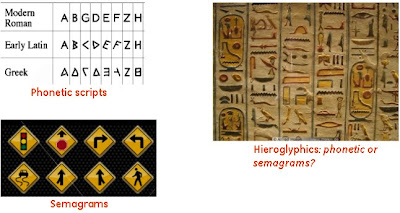Cracking the Hieroglyphics
With all the news around Egypt these days, it was fun to find a story that was non-political and non-current about the place: deciphering the hieroglyphics script.
The scholars of the 17th century who tried to decipher the hieroglyphics script of the Egyptians were unwilling to consider the possibility that it could be a phonetic script (a script where each symbol/character was associated with a sound/syllable). Instead they assumed that the Egyptian hieroglyphs were semagrams, i.e., each symbol/character was an entire idea or a word, not a syllable.

A part of the reason for this belief was the Egyptians-were-too-primitive-to-have-a-phonetic-script mindset of the Europeans. Another reason was that, well, the hieroglyphs do look like pictures, don’t they? And to put a seal on that belief, Athanasius Kircher, a highly respected Egyptologist and an author of a book on cryptography published a dictionary of his translations of the hieroglyphs. The man’s name carried so much weight that his view ruled.
And then the Rosetta Stone was discovered. The Rosetta Stone had the same text written in 3 languages: ancient Greek, demotic and hieroglyphics, one below the other.

You’d think the Rosetta Stone would have split the hieroglyphic script wide open. Unfortunately, scholars were still looking at hieroglyphs as semagrams. And so the Rosetta Stone didn’t quite help crack the “code” as fast as it should have. And then came Thomas Young who studied the Rosetta Stone and realized that the hieroglyphs were syllables. He even correctly identified the sounds associated with many of the hieroglyphs. And then Young stopped. Abruptly. Why? Because Young was convinced that Kircher was right and what he had found just proved that the ancient Egyptians may have used a few syllables to spell out foreign, non-Egyptian words (like the names of Greeks)!
Jean-Francois Champollion, a Frenchman, took up from where Young had left off. And Champollion went on to build a whole lot on top of what Young had done. And so Champollion walked away with the entire credit for cracking the hieroglyphs.
Before you feel too sorry for Young, remember it was Young who chose to stop because he assumed Kircher’s hieroglyphs-are-semagrams view was correct. And besides, Young is still remembered as the scientist who established the wave theory of light, by his famous Young’s double-slit experiment, by the constant (Young’s modulus) and the equation (Young-Laplace equation) named after him, and as the guy who figured out how we perceive colours (via 3 kinds of nerve fibres in the retina). So yeah, Young lost out on the hieroglyphs credit, but he sure didn’t lose out on all fronts, did he?
The scholars of the 17th century who tried to decipher the hieroglyphics script of the Egyptians were unwilling to consider the possibility that it could be a phonetic script (a script where each symbol/character was associated with a sound/syllable). Instead they assumed that the Egyptian hieroglyphs were semagrams, i.e., each symbol/character was an entire idea or a word, not a syllable.

A part of the reason for this belief was the Egyptians-were-too-primitive-to-have-a-phonetic-script mindset of the Europeans. Another reason was that, well, the hieroglyphs do look like pictures, don’t they? And to put a seal on that belief, Athanasius Kircher, a highly respected Egyptologist and an author of a book on cryptography published a dictionary of his translations of the hieroglyphs. The man’s name carried so much weight that his view ruled.
And then the Rosetta Stone was discovered. The Rosetta Stone had the same text written in 3 languages: ancient Greek, demotic and hieroglyphics, one below the other.

You’d think the Rosetta Stone would have split the hieroglyphic script wide open. Unfortunately, scholars were still looking at hieroglyphs as semagrams. And so the Rosetta Stone didn’t quite help crack the “code” as fast as it should have. And then came Thomas Young who studied the Rosetta Stone and realized that the hieroglyphs were syllables. He even correctly identified the sounds associated with many of the hieroglyphs. And then Young stopped. Abruptly. Why? Because Young was convinced that Kircher was right and what he had found just proved that the ancient Egyptians may have used a few syllables to spell out foreign, non-Egyptian words (like the names of Greeks)!
Jean-Francois Champollion, a Frenchman, took up from where Young had left off. And Champollion went on to build a whole lot on top of what Young had done. And so Champollion walked away with the entire credit for cracking the hieroglyphs.
Before you feel too sorry for Young, remember it was Young who chose to stop because he assumed Kircher’s hieroglyphs-are-semagrams view was correct. And besides, Young is still remembered as the scientist who established the wave theory of light, by his famous Young’s double-slit experiment, by the constant (Young’s modulus) and the equation (Young-Laplace equation) named after him, and as the guy who figured out how we perceive colours (via 3 kinds of nerve fibres in the retina). So yeah, Young lost out on the hieroglyphs credit, but he sure didn’t lose out on all fronts, did he?
Very interesting! Certainly more interesting than the present news about Egypt!
ReplyDelete